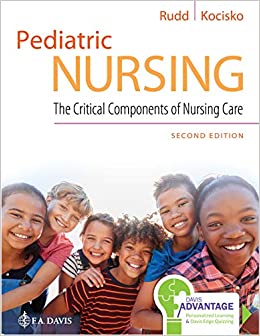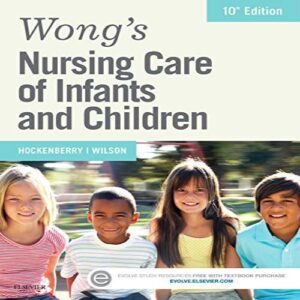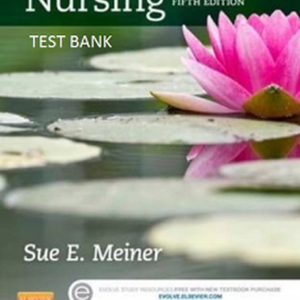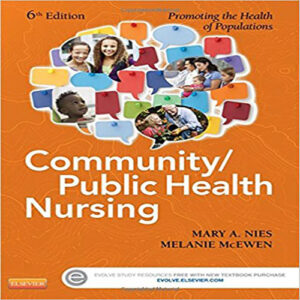Test Bank for Pediatric Nursing The Critical Components of Nursing Care 2nd Edition By Kathryn Rudd
ISBN-13: 9780803666535
Chapter 1. Issues and Trends in Pediatric Nursing
MULTIPLE CHOICE
1. A nurse is reviewing changes in healthcare delivery and funding for pediatric populations.
Which current trend in the pediatric setting should the nurse expect to find?
a. Increased hospitalization of children
b. Decreased number of uninsured children
c. An increase in ambulatory care
d. Decreased use of managed care
ANS: C
One effect of managed care is that pediatric healthcare delivery has shifted dramatically from the
acute care setting to the ambulatory setting. The number of hospital beds being used has
decreased as more care is provided in outpatient and home settings. The number of uninsured
children in the United States continues to grow. One of the biggest changes in healthcare has
been the growth of managed care.
DIF: Cognitive Level: Comprehension REF: p. 3
OBJ: Nursing Process Step: Planning MSC: Safe and Effective Care Environment
2. A nurse is referring a low-income family with three children under the age of 5 years to a
program that assists with supplemental food supplies. Which program should the nurse refer this
family to?
a. Medicaid
b. Medicare
c. Early and Periodic Screening, Diagnostic, and Treatment (EPSDT) program
d. Women, Infants, and Children (WIC) program
ANS: D
WIC is a federal program that provides supplemental food supplies to low-income women who
are pregnant or breast-feeding and to their children until the age of 5 years. Medicaid and the
Medicaid Early and Periodic Screening, Diagnostic, and Treatment (EPSDT) program provides
for well-child examinations and related treatment of medical problems. Children in the WIC
program are often referred for immunizations, but that is not the primary focus of the program.
Public Law 99-457 provides financial incentives to states to establish comprehensive early
intervention services for infants and toddlers with, or at risk for, developmental disabilities.
Medicare is the program for Senior Citizens.
DIF: Cognitive Level: Application REF: p. 7
OBJ: Nursing Process Step: Implementation
MSC: Health Promotion and Maintenance
3. In most states, adolescents who are not emancipated minors must have parental permission
before:
a. treatment for drug abuse.
b. treatment for sexually transmitted diseases (STDs).
c. obtaining birth control.
d. surgery.
ANS: D
An emancipated minor is a minor child who has the legal competence of an adult. Legal counsel
may be consulted to verify the status of the emancipated minor for consent purposes. Most states
allow minors to obtain treatment for drug or alcohol abuse and STDs and allow access to birth
control without parental consent.
DIF: Cognitive Level: Application REF: p. 12
OBJ: Nursing Process Step: Planning MSC: Safe and Effective Care Environment
4. A nurse is completing a clinical pathway for a child admitted to the hospital with pneumonia.
Which characteristic of a clinical pathway is correct?
a. Developed and implemented by nurses
b. Used primarily in the pediatric setting
c. Specific time lines for sequencing interventions
d. One of the steps in the nursing process
ANS: C
Clinical pathways measure outcomes of client care and are developed by multiple healthcare
professionals. Each pathway outlines specific time lines for sequencing interventions and reflects
interdisciplinary interventions. Clinical pathways are used in multiple settings and for clients
throughout the life span. The steps of the nursing process are assessment, diagnosis, planning,
implementation, and evaluation.
DIF: Cognitive Level: Comprehension REF: p. 6
OBJ: Nursing Process Step: Planning MSC: Safe and Effective Care Environment
5. When planning a parenting class, the nurse should explain that the leading cause of death in
children 1 to 4 years of age in the United States is:
a. premature birth.
b. congenital anomalies.
c. accidental death.
d. respiratory tract illness.
ANS: C
Accidents are the leading cause of death in children ages 1 to 19 years. Disorders of short
gestation and unspecified low birth weight make up one of the leading causes of death in
neonates. One of the leading causes of infant death after the first month of life is congenital
anomalies. Respiratory tract illnesses are a major cause of morbidity in children.
DIF: Cognitive Level: Application REF: p. 9
OBJ: Nursing Process Step: Implementation
MSC: Safe and Effective Care Environment
6. Which statement is true regarding the quality assurance or incident report?
a. The report assures the legal department that there is no problem.
b. Reports are a permanent part of the client’s chart.
c. The nurse’s notes should contain the following: Incident report filed and copy
placed in the chart.
d. This report is a form of documentation of an event that may result in legal action.
ANS: D
An incident report is a warning to the legal department to be prepared for potential legal action;
it is not a part of the clients’ chart or nurse documentation.
DIF: Cognitive Level: Knowledge REF: p. 14
OBJ: Nursing Process Step: Implementation
MSC: Safe and Effective Care Environment




